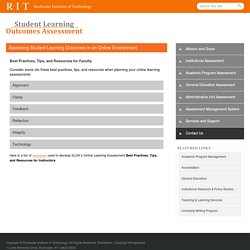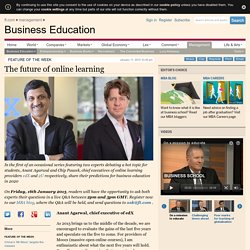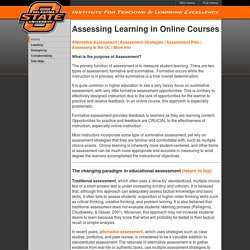

Onlineed.pdf. ‘On-line Assessment for E-Learning: Options and Opportunities’, 128 potential to provide new and innovative assessments modes and systems.

Disappoint-ingly, Ryan found that “preliminary searches for good examples of online assessmentreveal no mainstream examples of the potential of the new media to construct authen-tic, valid and meaningful evaluation of the range of student learning … (but rather) …a trivialisation of content knowledge, diminished to the level of true/false answers,matching exercises, multiple choice questions of the lowest common denominator level which undermines the very learning that we now all agree is essential for our stu-dents” Some of this lack of innovation in assessment may stem from the need todispel the perception that e learning is somehow “second class learning.” Hence uni-versities undertaking. RoblesAndBraathen2002.pdf. Sewell_0310.pdf. Assessment in Online Distance Education: A Comparison of Three Online Programs at a University. Onlineed.pdf. Course_based.pdf. Online-assessment.pdf. Assessment in Online Distance Education: A Comparison of Three Online Programs at a University.
Resources.pdf. Assessing Student Learning Outcomes in an Online Environment. ALIGNMENT: Use assessments that align to learning outcomes and work well in an online environment.

Aligning the learning outcomes from your course with assessment strategies will give you the opportunity to check that your students are accomplishing the learning outcomes. Using a variety of assessment techniques throughout the course provides instructors with the best picture of their students' learning. While there is no rule about what works best, and different subject matters call for different types of assessments, the following are some generalized methods that work well in an online environment (adapted from Palloff and Pratt, 2009).
CLARITY: Write clear assignment instructions, use grading rubrics, and share them with students. In an online environment, the potential for students to become confused by coursework expectations may be higher than in a traditional class setting. Guidelines for written assignment instructions Good feedback skills guidelines. JOLT - Journal of Online Learning and Teaching. Lorna R.

Kearns Senior Instructional Designer Center for Instructional Development and Distance Education University of Pittsburgh Pittsburgh, PA 15213 USA lrkearns@pitt.edu Introduction With nearly 30% of U.S. college and university students now taking at least one online course, online learning enrollments in this country continue to grow at a much faster rate than overall enrollments in higher education (Allen & Seaman, 2010).
More widely, the International Council for Open and Distance Education predicts that open and distance learning delivery formats will become the most significant driver of transnational higher education (Walsh, 2009). As this new mode of instruction becomes more prevalent, it is important to study the design and teaching of online courses. EDU03150. The future of online learning. In the first of an occasional series featuring two experts debating a hot topic for students, Anant Agarwal and Chip Paucek, chief executives of online learning providers edX and 2U respectively, share their predictions for business education in 2020 On Friday, 16th January 2015, readers will have the opportunity to ask both experts their questions in a live Q&A between 2pm and 3pm GMT.

Register now to our MBA blog, where the Q&A will be held, and send questions to ask@ft.com. Anant Agarwal, chief executive of edX As 2015 brings us to the middle of the decade, we are encouraged to evaluate the gains of the last five years and speculate on the five to come. For providers of Moocs (massive open online courses), I am enthusiastic about what the next five years will hold. . • Students worldwide will have access to virtually any course subject in just about any language - tens of thousands of free Moocs offering everything from fine arts to engineering. . • Moocs will get personal. Oklahoma State University - Stillwater - Home. Alternative Assessment | Assessment Strategies | Assessment Plan | Assessing in the OC | More info What is the purpose of Assessment?

The primary function of assessment is to measure student learning. There are two types of assessment, formative and summative. Formative occurs while the instruction is in process, while summative is a final overall determination. It is quite common in higher education to see a very heavy focus on summative assessment, with very little formative assessment opportunities. Formative assessment provides feedback to learners as they are learning content. Most instructors incorporate some type of summative assessment, yet rely on assessment strategies that they are familiar and comfortable with, such as multiple choice exams. The changing paradigm in educational assessment (return to top) Traditional assessment, which often uses a 'drive-by' standardized, multiple-choice test or a short-answer test is under increasing scrutiny and criticism. Achtemeier, S. Assessment in Online/Blended Learning Environments. In considering the incorporation of formative and summative assessments into online and blended learning environments, it’s striking how similar the considerations are to traditional assessments.

Formative assessments continue to be designed for learning and monitoring students’ progress. The goal continues to be the same: engage in formative assessment to support students through the learning process and use results to adapt to students’ needs to understand the material. Summative assessments of learning continue to be designed as an evaluation at the end of a learning objective. Timely feedback and use of the testing data to improve instruction continue to be crucial elements of the purposefulness of the assessments. While the purpose of the assessments continue to be the same, there are some nice differences to be found with Web 2.0 tools that support the formative and summative assessment process. Like this: Like Loading...